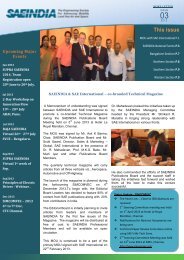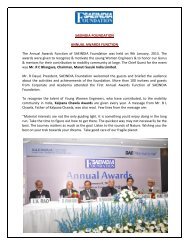The Kerosene Marking Programme In India - SAEINDIA
The Kerosene Marking Programme In India - SAEINDIA
The Kerosene Marking Programme In India - SAEINDIA
Create successful ePaper yourself
Turn your PDF publications into a flip-book with our unique Google optimized e-Paper software.
PROGRAM WAS IMPLEMENTED. IN ADDITION<br />
TO THE ECONOMIC RETURNS, IT WILL ALSO<br />
DISCUSS HOW THE PROGRAM POSITIVELY<br />
IMPACTS THE NATION’S POOR.<br />
THE PROBLEM<br />
Diesel & gasoline are the major transport fuels in<br />
<strong>In</strong>dia. Adulteration of these transport fuels takes place<br />
at the point of sale and during transportation.<br />
Transport fuels are often adulterated with cheaper<br />
products. For example, diesel and gasoline are widely<br />
adulterated with kerosene. Unfortunately, fuel<br />
adulteration is often an organised criminal industry<br />
and is growing rapidly; it is an unpleasant reality that<br />
impacts every brand owner and the government. <strong>In</strong><br />
addition, fuel adulteration can lead to increases in air<br />
pollution and degradation of vehicle performance<br />
(which, in turn, can lead to brand erosion).<br />
Adulteration is indulged primarily due to differential<br />
pricing mechanism of fuels & adulterants and easy<br />
availability of adulterants in the market. <strong>The</strong><br />
adulterants being taxed lower than the base fuels or<br />
subsidized kerosene gives monetary benefits when<br />
mixed with a proportion of base fuel. <strong>The</strong> incentive is<br />
the huge price difference — while subsidised kerosene<br />
costs roughly about Rs. 10 a litre, gasoline is priced at<br />
Rs. 45 and diesel at Rs. 35 a litre.<br />
Table 1: Retail prices for gasoline, diesel and<br />
kerosene<br />
Fuel Annual<br />
Consumption<br />
Millions (kl)<br />
Price(Rs/litre<br />
)<br />
Price($/litre<br />
)<br />
Gasoline 89 45 1.12<br />
Diesel 40 35 0.88<br />
<strong>Kerosene</strong> 12 10 0.25<br />
Additionally, the penalties that could act as a strong<br />
deterrent to fuel adulteration are often lacking. <strong>The</strong>re<br />
are number of reasons for fuel comingling to take<br />
place, including poor governance/lack of monitoring<br />
systems, a lack of political will, weak regulatory<br />
framework and lack of public awareness.<br />
<strong>In</strong> summary, the primary factors encouraging the<br />
practice of fuel adulteration are:<br />
• High profit – fuel adulteration is extremely<br />
lucrative, particularly if an adulterated product<br />
is sold at or close to the price of the genuine<br />
product/nonadulterated product. <strong>The</strong> high<br />
profits are possible due to the existence of<br />
differential price levels amongst the fuels,<br />
intermediate products and byproducts – the<br />
adulterants are lower than the prices of the<br />
fuels to be adulterated, providing financial<br />
gains when mixing a proportion of higher<br />
priced fuel with lower subsidised products.<br />
<strong>The</strong> differential pricing mechanism of fuels<br />
and adulterants, and the availability of<br />
adulterants in the market, are also factors.<br />
• Low risk – penalties, and the chance of getting<br />
caught, have been relatively low. Most<br />
jurisdictions regard fuel adulteration cases as<br />
civil crimes and prosecutors may be hesitant<br />
to pursue fuel adulteration cases unless they<br />
are ”watertight”. A lack of control systems,<br />
weak legal frameworks/penalty system and<br />
limited consumer awareness of the problem<br />
make fuel adulteration a low risk illegal<br />
activity.<br />
Studies have shown that a significant portion of <strong>In</strong>dia’s<br />
subsidized PDS kerosene has been diverted for the<br />
purpose of adulterating diesel. <strong>In</strong> September 2005, a<br />
study by <strong>In</strong>dian’s National Council for Applied<br />
Economic Research (NCAER) study concluded that<br />
38.6% of PDS kerosene was being diverted for black<br />
marketing and adulteration in petrol and diesel. <strong>The</strong><br />
incentive being the huge price difference.<br />
Several studies showed an alarming rise in the cases<br />
of fuel adulteration. It is estimated that 30% of the<br />
PDS kerosene was diverted to the black market for<br />
and adulteration during 1994. <strong>The</strong> same figure has<br />
now risen to 38.6%, an increase of 28.6% in 11 years.<br />
<strong>The</strong> gap between the annual PDS kerosene supply<br />
(11,400 kilolitres) and PDS kerosene purchase (7,300<br />
kilolitres) is high. However, not all kerosene diverted<br />
from the PDS scheme is used for fuel adulteration.<br />
<strong>The</strong> gap between estimated household kerosene<br />
consumption and PDS supply is in the order of 18%.<br />
Half of the diverted kerosene ends up in households<br />
for use by people who do not posses a ration card or it<br />
is purchased by nonPDS residents at black market<br />
prices. It is projected that the share of nonhousehold<br />
kerosene use is 18.1%, the black market activity is<br />
17.9% and the use by noncard holders 2.6%.<br />
Various estimates have been made of the extent of<br />
financial loss to the national exchequer as well as the<br />
oil companies as a result of diversion of PDS<br />
kerosene and getting mixed with diesel, evasion of<br />
sales tax etc. If to this is added the social costs as the<br />
result of environmental pollution, damage to vehicles<br />
etc, the loss is substantially higher.<br />
<strong>The</strong> findings in a paper entitled, “On Need for Urgent<br />
Adjustment of Prices and Taxes on Petroleum<br />
Products,” published by <strong>The</strong> Associated Chambers of<br />
Commerce and <strong>In</strong>dustry of <strong>In</strong>dia (ASSOCHAM) states<br />
that the subsidy burden for the government at the<br />
prices in 200607 is estimated at Rs15,000 crore.<br />
It is estimated that the losses for diversion are in the<br />
order of Rs10,000 crore (direct fiscal subsidy plus<br />
underrecovery by the oil companies).<br />
THE SOLUTION<br />
<strong>The</strong> government and public sector oil marketing<br />
companies (OMCs) have taken various steps to<br />
contain the menace of adulteration and one of these<br />
2







